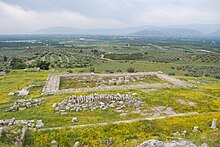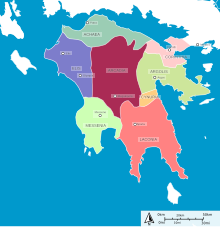|
IBERIA. Konterbia Karbika
Bronze 25mm (11.5 grams) Struck circa 150-100 B.C.
Reference: ACIP 1829; SNG BM Spain 1020-4
Beardless male bust right, dolphin before, Iberian legend KARBIKA behind.
Horseman right, holding spear, Iberian legend KONTEBAKOM.
You are bidding on the exact item pictured, provided with a Certificate of Authenticity and Lifetime Guarantee of Authenticity.
 Argos is a city in Argolis, Peloponnese, Greece and one of the oldest continuously inhabited cities in the world. It is also a former bishopric and present Latin Catholic titular see. It is the biggest town in Argolis and a major center for the area. Since the 2011 local government reform it has been part of the municipality of Argos-Mykines, of which it is a municipal unit. The municipal unit has an area of 138.138 km2. It is 11 kilometres (7 miles) from Nafplion, was its historic harbour. A settlement of great antiquity, Argos has been continuously inhabited as at least a substantial village for the past 7,000 years. The city is a member of the Most Ancient European Towns Network. Argos is a city in Argolis, Peloponnese, Greece and one of the oldest continuously inhabited cities in the world. It is also a former bishopric and present Latin Catholic titular see. It is the biggest town in Argolis and a major center for the area. Since the 2011 local government reform it has been part of the municipality of Argos-Mykines, of which it is a municipal unit. The municipal unit has an area of 138.138 km2. It is 11 kilometres (7 miles) from Nafplion, was its historic harbour. A settlement of great antiquity, Argos has been continuously inhabited as at least a substantial village for the past 7,000 years. The city is a member of the Most Ancient European Towns Network.
A resident of the city of Argos is known as an Argive. However, this term is also used to refer to those ancient Greeks generally who assaulted the city of Troy during the Trojan War; the term is more widely applied by the Homeric bards. Numerous ancient monuments can be found in the city today, the most famous of which is the Heraion of Argos. Agriculture is the mainstay of the local economy.
Etymology
The name of the city is very ancient and several etymological theories have been proposed as an explanation to its meaning. The most popular one maintains that the name of the city is a remainder from the Pelasgian language, i.e. the one used by the people who first settled in the area, in which Argos meant “plain”. Alternatively, the name is associated with Argos, the third king of the city in ancient times, who renamed it after himself, thus replacing its older name Foronikon Asty (Φορωνικόν Άστυ). It is also believed that “Argos” is linked to the word “αργός” (argós), which meant “white”; possibly, this had to do with the visual impression given of the argolic plain during harvest time. According to Strabo, the name could have even originated from the word “αγρός” (=field) by antimetathesis of the consonants.
History Antiquity
As a strategic location on the fertile plain of Argolis, Argos was a major stronghold during the Mycenaean era. In classical times Argos was a powerful rival of Sparta for dominance over the Peloponnese, but was eventually shunned by other Greek city-states after remaining neutral during the Greco-Persian Wars. There is evidence of continuous settlement in the area starting with a village about 7000 years ago in the late Neolithic, located on the foot of Aspida hill.:124- It was colonized in prehistoric times by the Pelasgian Greeks. Since that time, Argos has been continually inhabited at the same geographical location. Its creation is attributed to Phoroneus, with its first name having been Phoronicon Asty, or the city of Phoroneus. The historical presence of the Pelasgian Greeks in the area can be witnessed in the linguistic remainders that survive up to today, such as the very name of the city and “Larissa”, the name of the city’s castle located on the hill of the same name, meaning “citadel”.
The city is located at a rather propitious area, among Nemea, Corinth and Arcadia. It also benefitted from its proximity to lake Lerna, which, at the time, was at a distance of one kilometre from the south end of Argos. During the Dorian invasion, c. 1100 BC, Argos was divided into four neighbourhoods, each of them inhabited by a different phyle.
Argos was a major stronghold of Mycenaean times, and along with the neighbouring acropolis of Mycenae and Tiryns became a very early settlement because of its commanding positions in the midst of the fertile plain of Argolis. Argos experienced its greatest period of expansion and power under the energetic 7th century BC ruler King Pheidon. Under Pheidon, Argos regained sway over the cities of the Argolid and challenged Sparta’s dominance of the Peloponnese. During this time of its greatest power, the city boasted a pottery and bronze sculpturing school, pottery workshops, tanneries and clothes producers. Moreover, at least 25 celebrations took place in the city, in addition to a regular local products exhibition. A sanctuary dedicated to Hera was also found at the same spot where the monastery of Panagia Katekrymeni is located today.
Argos remained neutral or the ineffective ally of Athens during the 5th century BC struggles between Sparta and Athens. This, however, led to its weakening and loss of power, which in turn led to the shift of commercial focus from the Ancient Agora to the eastern side of the city, delimited by Danaou and Agiou Konstadinou streets.
Argos in Greek mythology
The mythological kings of Argos are (in order): Inachus, Phoroneus, Argus, Triopas, Agenor, Iasus, Crotopus, Pelasgus (aka Gelanor), Danaus, Lynceus, Abas, Proetus, Acrisius, Perseus, Megapenthes, Argeus and Anaxagoras. An alternative version supplied by Tatian of the original 17 consecutive kings of Argos includes Apis, Argios, Kriasos and Phorbas between Argus and Triopas, explaining the apparent unrelation of Triopas to Argus.
The city of Argos was believed to be the birthplace of the mythological character Perseus, the son of the god Zeus and Danaë, who was the daughter of the king of Argos, Acrisius.
After the original 17 kings of Argos, there were three kings ruling Argos at the same time (see Anaxagoras), one descended from Bias, one from Melampus, and one from Anaxagoras. Melampus was succeeded by his son Mantius, then Oicles, and Amphiaraus, and his house of Melampus lasted down to the brothers Alcmaeon and Amphilochus.
Anaxagoras was succeeded by his son Alector, and then Iphis. Iphis left his kingdom to his nephew Sthenelus, the son of his brother Capaneus.
Bias was succeeded by his son Talaus, and then by his son Adrastus who, with Amphiaraus, commanded the disastrous Seven Against Thebes. Adrastus bequeathed the kingdom to his son, Aegialeus, who was subsequently killed in the war of the Epigoni. Diomedes, grandson of Adrastus through his son-in-law Tydeus and daughter Deipyle, replaced Aegialeus and was King of Argos during the Trojan war. This house lasted longer than those of Anaxagoras and Melampus, and eventually the kingdom was reunited under its last member, Cyanippus, son of Aegialeus, soon after the exile of Diomedes.
Gallery
 The Heraion of Argos The Heraion of Argos
 Ancient Peloponnese Ancient Peloponnese
 View of the ancient theatre View of the ancient theatre
 The Heraion of Argos. The Heraion of Argos.
|





 Argos is a city in Argolis, Peloponnese, Greece and one of the oldest continuously inhabited cities in the world. It is also a former bishopric and present Latin Catholic titular see. It is the biggest town in Argolis and a major center for the area. Since the 2011 local government reform it has been part of the municipality of Argos-Mykines, of which it is a municipal unit. The municipal unit has an area of 138.138 km2. It is 11 kilometres (7 miles) from Nafplion, was its historic harbour. A settlement of great antiquity, Argos has been continuously inhabited as at least a substantial village for the past 7,000 years. The city is a member of the Most Ancient European Towns Network.
Argos is a city in Argolis, Peloponnese, Greece and one of the oldest continuously inhabited cities in the world. It is also a former bishopric and present Latin Catholic titular see. It is the biggest town in Argolis and a major center for the area. Since the 2011 local government reform it has been part of the municipality of Argos-Mykines, of which it is a municipal unit. The municipal unit has an area of 138.138 km2. It is 11 kilometres (7 miles) from Nafplion, was its historic harbour. A settlement of great antiquity, Argos has been continuously inhabited as at least a substantial village for the past 7,000 years. The city is a member of the Most Ancient European Towns Network. The Heraion of Argos
The Heraion of Argos  Ancient Peloponnese
Ancient Peloponnese  View of the ancient theatre
View of the ancient theatre  The Heraion of Argos.
The Heraion of Argos. 




